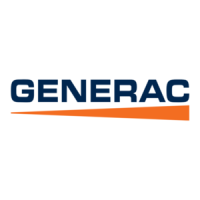6
Generac Portable Products 2100 PSI Pressure Washer
• Insert the carriage bolt through the left hole (from the
rear of the unit) and attach a plastic knob. Tighten by
hand (Figure 2).
• Insert the carriage hook through the right hole (from the
rear of the unit). Pull the recoil handle out slowly. Place
the recoil string through the hook and attach the plastic
knob. Tighten by hand (Figure 2).
• Insert the wire form with the longer arm positioned on
the left. From the rear of the unit, the hook should
resemble a “J” (Figure 3).
Add Engine Oil
IMPORTANT: Any attempt to crank or start the engine
before it has been properly serviced with the
recommended oil may result in an engine failure.
• Place pressure washer on a level surface.
• Refer to the engine owners manual to add recommended
oil to engine.
NOTE: Check oil often during engine break–in. Refer to
engine owner’s manual for recommendations.
Add Gasoline
WARNING! Never fill fuel tank indoors. Never
fill fuel tank when engine is running or hot. Do Not
smoke when filling fuel tank.
WARNING! Never fill fuel tank completely full.
Provide space for fuel expansion. Wipe away any
fuel spillage from engine and equipment before
starting.
•
Use fresh, clean unleaded automotive gasoline and store in
approved, clean, covered containers. Use clean fill
funnels. Never use “stale” gasoline left over from last
season or gasoline stored for long periods.
• Clean area around fuel fill cap, remove cap.
• Slowly add "UNLEADED" regular gasoline to fuel tank.
Use a funnel to prevent spillage. Slowly fill tank to about
1.5" below the bottom of the filler neck (Figure 4).
• Install fuel cap and wipe up any spilled gasoline.
Connect Hose and Water Supply to
Pump
IMPORTANT: You must attach all hoses before you start
the engine. Starting engine without all hoses connected and
water supplied will damage the pump.
• Uncoil the high pressure hose and attach one end of the
hose to the base of the spray gun (Figure 5). Tighten by
hand.
Figure 3 — Attach Wire Form to Handle
Figure 2 — Secure Handle
Figure 4 — Typical Fuel Expansion Space
Fuel
Tank
1.5” Airspace

